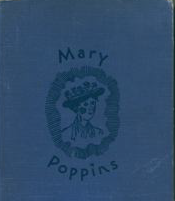 Ever since I began working for the Museum in September 2009 and learned that we’d be offering a Film of the Month for our guests, I anxiously awaited the showing of Mary Poppins. It had always been my favorite Disney feature-length film, and when it was finally scheduled to run this month, I was thrilled. Not only did I have the chance to watch it again in our intimate Fantasia-themed theater, I also had the pleasure of introducing it to visitors throughout the month, and then making the book behind the movie the focus of our March Look Closer presentation.
Ever since I began working for the Museum in September 2009 and learned that we’d be offering a Film of the Month for our guests, I anxiously awaited the showing of Mary Poppins. It had always been my favorite Disney feature-length film, and when it was finally scheduled to run this month, I was thrilled. Not only did I have the chance to watch it again in our intimate Fantasia-themed theater, I also had the pleasure of introducing it to visitors throughout the month, and then making the book behind the movie the focus of our March Look Closer presentation.

Displayed in a small case in Gallery 9, the book Mary Poppins, by Australian author P.L. Travers, is the actual copy sent hot off the presses to Walt by publisher Reynal and Hitchcock in 1934. Visitors to the Museum can see the signature of Eugene Reynal on the inside of the cover, along with the inscription that reads, “To Walt Disney—Not another ‘Mickey’ but I think you should like our Mary.”
Although Walt found the story of the beloved English nanny to be perfect material for a Disney film, Mrs. Travers didn’t agree. As early as 1944, Walt tried to secure the film rights to the book, but it took more than fifteen years before he succeeded. One of the early pieces of correspondence from Walt to the reluctant author shows the beginning of the campaign to persuade her: “It is our thought that these stories would be ideal material for a combination of flesh and blood characters with cartoon.”
Eventually Mrs. Travers was won over, but not without Walt first granting her final script approval. Even with that concession, however, the author was never satisfied with the final product. Fortunately, the public and critics felt otherwise. Mary Poppins went on to become one of the Studio’s greatest successes, grossing more than $75 million after its 1964 premiere at Grauman’s Chinese Theatre in Hollywood.
In a letter to Walt dated September 11, 1964, the famous film producer, Samuel Goldwyn, wrote about Mary Poppins: “Once in a lifetime—and only once—a picture comes along which cannot be compared to any other and to which no other can be compared. A picture which [sic] writes a new page in motion picture history. A picture that has such universal appeal that it is a pure delight to fathers, mothers, children, grandparents and grandchildren—it makes no difference who.”
 Mary Poppins earned 13 Academy Award® nominations, even more significant since this was the first time a Disney film was in contention in leading categories such as Best Picture, Best Director, Best Actress, and Best Adapted Screenplay. While it didn’t receive Best Picture (that honor went to My Fair Lady), the film did score five Oscars®, including Best Actress for its star, Julie Andrews, and Best Musical Score, for the 18 songs composed by the famous duo of Richard and Robert Sherman.
Mary Poppins earned 13 Academy Award® nominations, even more significant since this was the first time a Disney film was in contention in leading categories such as Best Picture, Best Director, Best Actress, and Best Adapted Screenplay. While it didn’t receive Best Picture (that honor went to My Fair Lady), the film did score five Oscars®, including Best Actress for its star, Julie Andrews, and Best Musical Score, for the 18 songs composed by the famous duo of Richard and Robert Sherman.
(An interesting side note to this second award is that one of the songs, “Feed the Birds,” was reportedly not only Walt’s favorite song from the film, but also his favorite song in general. Apparently, Walt just needed to say, “Play it” for the Sherman Brothers to know that he wanted to hear the haunting melody.)
To see photographs of Walt with the Sherman Brothers and other crew and cast members of Mary Poppins, as well as letters from Walt to Julie Andrews concerning her role in the film, Museum visitors can make their way to the area devoted to this special production in the lower level of Gallery 9.

Mary Beth Culler
Museum Interpreter at The Walt Disney Family Museum
